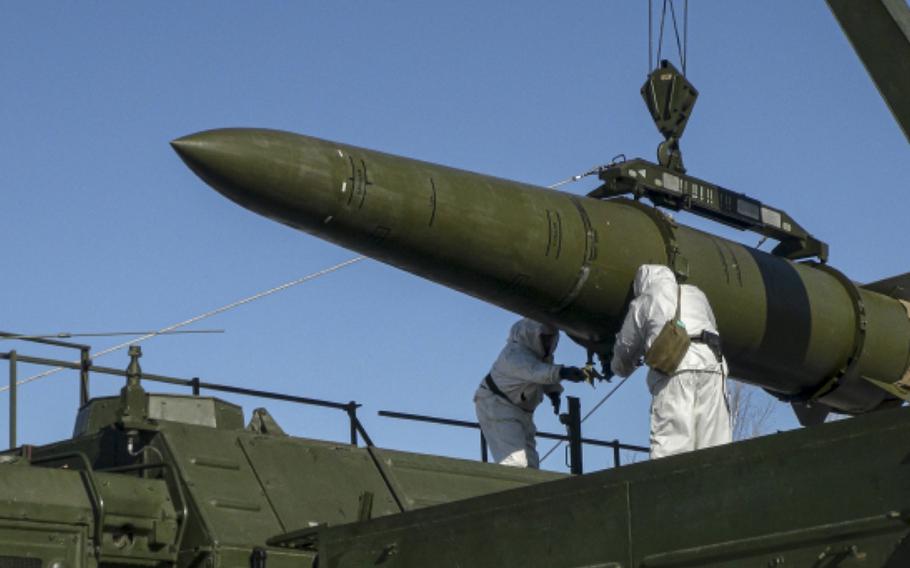
Russian troops load an Iskander missile onto a mobile launcher during drills at an undisclosed location in Russia. (Russian Defense Ministry Press Service)
Worldwide military spending surged by 9% year over year in 2023 to hit a record $2.2 trillion as multiple conflicts ratcheted up global insecurity, according to a new report by the International Institute for Strategic Studies released Tuesday.
The report, IISS’s 65th annual “Military Balance” publication, also estimated that military spending would set another record this year, as these conflicts continued to make their impact felt.
Speaking to journalists in London, IISS Director General Bastian Giegerich said that multiple factors represented “a picture of strategic instability and a new era of contested power.” He cited Russia’s ongoing invasion of Ukraine, China’s military modernization, the conflicts in the Middle East and military coups in Africa.
The IISS report also highlighted the intense destructiveness of war. In Ukraine, the IISS estimated that Russia has lost roughly 3,000 main battle tanks since it invaded in February 2022. Those losses exceeded the total of tanks in Russia’s active inventory before the war, forcing it to pull older vehicles out of storage.
Meanwhile, NATO member states’ defense spending has risen to about 50% of the global total, the IISS report stated, a staggering proportion for a military alliance whose member states account for less than an eighth of the world’s population.
The new estimates of growing global military budgets coincide with repeated remarks by former president Donald Trump on the levels of U.S. allies’ defense spending. He said at one weekend campaign rally that he would encourage Russia to do “whatever the hell they want” to NATO members who didn’t spend the alliance’s target of 2% of gross domestic product on defense.
“You didn’t pay. You’re delinquent,” Trump claimed to have told a foreign leader when he was president.
Ukraine war pushes Europe
While the United States still accounts for the bulk of NATO defense spending, the London-based IISS found that non-U.S. members have collectively increased their military spending by 32% in the decade since Russia illegally annexed Crimea in 2014, with most of the growth occurring in the past two years.
Last year, 10 European Union member states reached the stated objective of spending 2% of their GDP on defense, up from eight the year before. All European NATO members hit the benchmark of allotting 20% of their spending to equipment, the IISS found.
The alliance has also been boosted by Finland, a new member as of last year and one with a large standing army, and by the likely accession of Sweden. Several large nations, including France and Germany, have announced long-term plans to boost spending.
However, the IISS also noted that some of those countries, particularly Germany, remain far below the 2% GDP target. Just last year, NATO members rejected a pledge to ensure their defense budgets went over 2%.
The IISS also warned that inflation and economic disruption have blunted the impact of some of the increases in defense spending, while a spike in demand has run into the reality that “European arms production was not geared for wartime.”
Russia and China continue to boost budgets
While the West is spending more on military budgets, so are Russia and China. And with lower costs and heavy state involvement in the defense industry, they often appear to be getting more for their money.
Russia’s total military expenditure increased by almost 30% last year as the war in Ukraine ground on, the IISS reported, with the Kremlin now estimated to be spending roughly 7.5% of its GDP on the military. The country has significantly overhauled its defense industry since it became apparent it was not prepared for the war in Ukraine.
Russia’s total military expenditure was estimated at $108 billion in 2023, more than three times the expenditure by Ukraine ($31 billion). Unlike Russia, however, Ukraine has often been able to replace lost equipment with better, Western-supplied equivalents, the IISS noted.
Military aid to Ukraine has become hostage to a bitter political divide in the United States. The Senate advanced $60 billion in assistance for Ukraine this week, but hard-right lawmakers in the House are expected to attempt to block it.
Last year, China increased its defense spending for the 29th consecutive year, the IISS reported, though lower-than-expected economic growth helped ensure that its share of GDP remained below 2%. Beijing is in the midst of a military modernization program designed to create a “world-class” military that relies less on foreign technology by the middle of the century, the IISS noted.
China’s ambitions have helped spur military spending among its neighbors, with Taiwan announcing its largest military budget at $19 billion — or around 2.6% of GDP. Japan and South Korea have also boosted their military spending, the IISS said, partly due to threats from North Korea.
The United States remained the world’s largest military spender; its $900 billion budget in 2023 was greater than those of the next top 15 countries combined. But while the war in Ukraine has stretched the U.S. defense industry, the IISS found that spending as a percentage of GDP — 3.36% in the United States — was lower than in previous eras.
“This compares to defense spending in the Cold War that was reaching 8% on a much smaller GDP,” Dana Allin, a fellow with IISS, told reporters in London. “So obviously this isn’t much of a strain for the United States.”